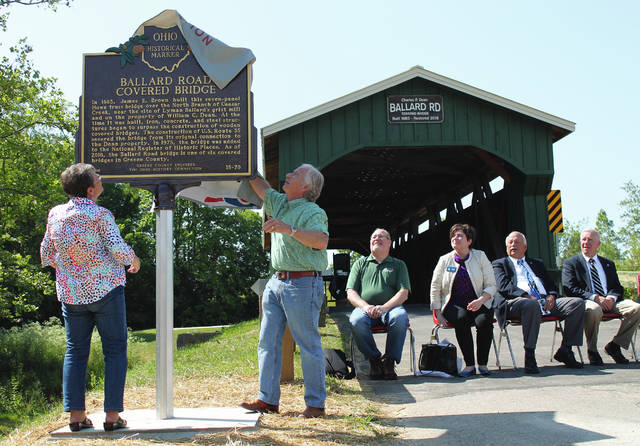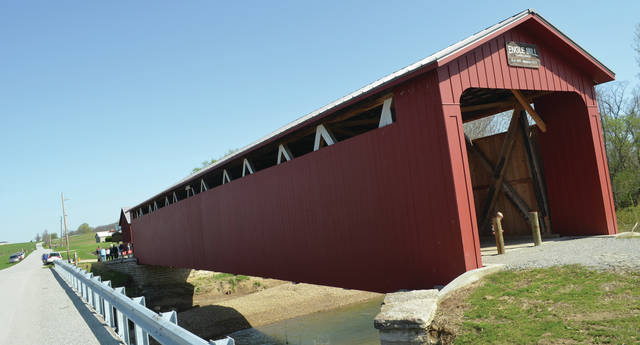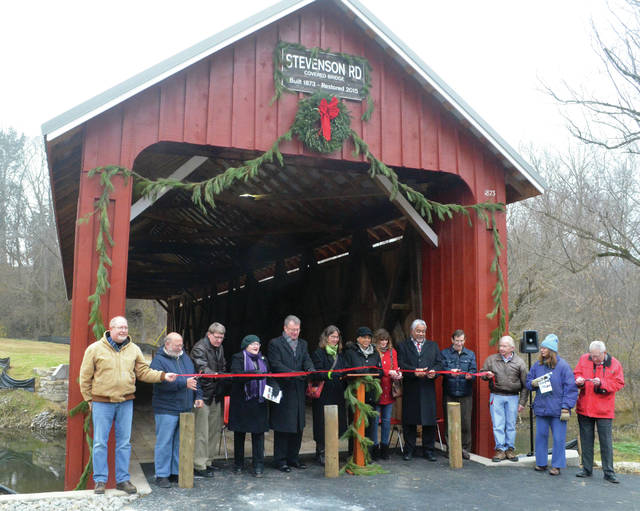





XENIA — In his 22 years as Greene County engineer, Bob Geyer worked to keep drivers safe on county roads and preserved a little local history, too.
He retired May 31.
But Geyer, Xenia-born and a Class of ’66 Xenia High School graduate, worked more than those two decades in the county engineer’s office. He also worked in the summers, while home from Purdue University, for County Engineer Dewey Ackerman; then for County Engineer Ray Kline; and later, as deputy engineer for County Engineer Dick Eastman.
Before Geyer was elected in 1996, he was also the project engineer on many projects — locally, like on Fairfield Road; and around the country on some of the largest public works projects at that time. He helped construct the West Virginia Turnpike and built a bridge across Narragansett Bay in Rhode Island.
Later, as project engineer for Stargel Construction in the 1990s, Geyer played a part in the creation of the bikeway from Xenia to Yellow Springs.
“It was challenging … it was interesting,” Geyer said. “It creates its own challenges when you’re working on a long narrow corridor, just things people don’t think about, like how do you get asphalt? You only have one way in and one way out.”
Ed Dressler, who propelled the bikeway vision forward, commended Geyer’s work.
“If Bob did not do that job, I do not think the bikeway would have been built or at least not to the standards Bob wanted done,” Dressler said. “He was on the job getting dirty like the employees. He recommended many change orders that ODOT honored … So we all owe Bob a job well done to help set standards and guidance for bikeways and, above all, the Little Miami Scenic Trail.”
Geyer took office Jan. 1, 1997. He took his county seat just days before Coroner Kevin Sharrett, former Clerk of Courts Terri Mazur and Commissioner Shawn Campbell took theirs.
“That makes me the most senior elected official until Friday at midnight,” Geyer said.
Geyer was only opposed that one election, beating Xenia City Engineer David Beach for the spot.
As county engineer, Geyer shifted his focus to roads and bridges.
“Since I’ve been here, all major structures — like all the bridges over the Little Miami River — have been rehabilitated, everything from painting to new decks to new guardrail, whatever needed to be done to bring the bridge up to current standards,” Geyer said.
The office has also completed many public works projects with intersection improvements, he said, and has leveraged the bridge levy to complete crucial bridge work.
“He’s done a wonderful job keeping our roads and bridges up to par with a limited budget at times,” County Administrator Brandon Huddleson said. “We appreciate everything Bob’s done to maintain our roads and bridges and get us here and back safely.”
As Geyer makes the move to Florida with his wife Kathy, there’s one thing he won’t miss.
“I’m not going to miss winter. I’m not going to miss the snow; I’m not going to miss the ice; I’m not going to miss — When are we gonna go out? What are we gonna do? How are we gonna do it? Do we have enough salt? — all those decisions,” Geyer said.
The county engineer admitted snow and ice removal might have been the most challenging part of the job, particularly budgeting for it.
“There were years when I had to spend more than I planned on spending because salt got more expensive, or we used more than we thought we’d use. You can burn through a lot of money real quick with snow and ice,” he said.
Geyer said it takes 100 tons of salt to go around the county once, but one time is never enough. The best price for salt in recent years was $50 per ton, he said.
“It goes up and down like a yo-yo,” Geyer said, adding that this year’s price was $93 per ton.
A new product called Beet Heet has helped some — allowing crews to use half as much salt as before.
Over the years, a lot has changed — from salt prices to new technology to the number of employees.
“I just enjoy working with the people here,” Geyer said. “You’re only as good as your staff and I’ve got a top notch staff here.”
But perhaps the project most dear to Geyer is his restoration of covered bridges.
He and his team rehabbed and rebuilt historic covered bridges on Engle Mill, Stevenson, Ballard, Hyde and Charleton Mill roads.
“I waited until I had what I felt was a nice surplus of money, something I could use to do that work without taking away from the necessary work that needed to be done on other bridges,” Geyer said, explaining that the other 80 percent of the funding came from federal funds specifically for covered bridges. “I used that window of opportunity to restore those bridges to try to save some history because once history is gone, you’re never gonna get it back.”
Geyer talked about Hyde Road Covered Bridge in Yellow Springs, a single lane bridge built by the railroad in the early 1900s. Geyer took the bridge’s design and coupled it with the look of Yellow Springs Station and Xenia Station — a cupola on top, long narrow windows on the side looking out over the bikeway below. He dedicated that bridge to Eastman.
The bridge on Charleton Mill, upon completion, was renamed the Robert N. Geyer Charleton Mill Road Covered Bridge.
Geyer’s replacement is Acting County Engineer Stephanie Goff — now one of three female county engineers in the state. Geyer said she’s “more than qualified” and is “going to do a fine job”.
“It’s been fun and it’s time to move on,” Geyer said. “The road to success is always under construction, right? Change is good.”




